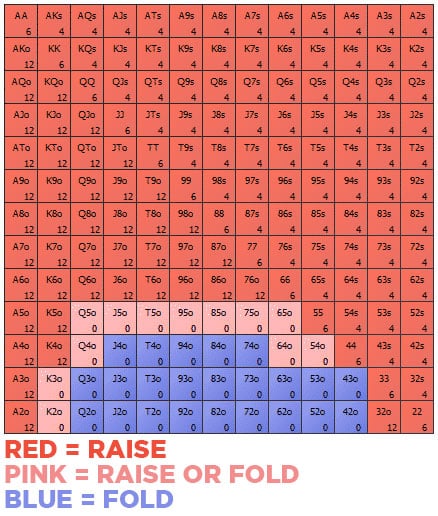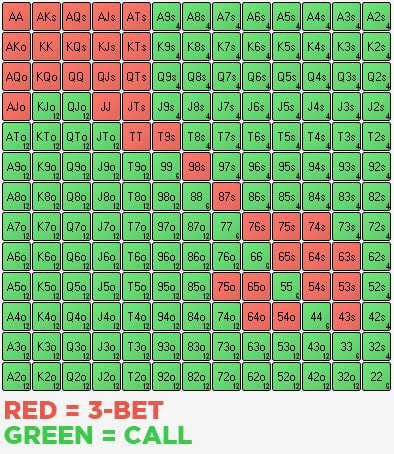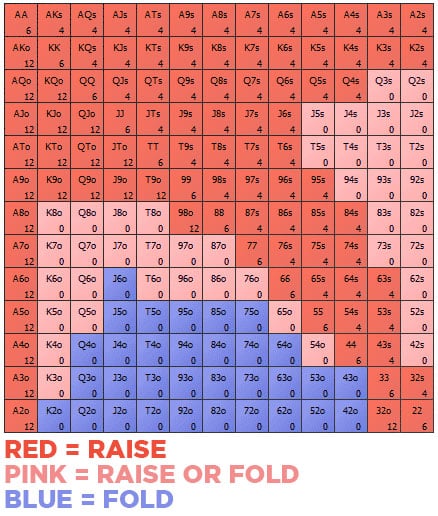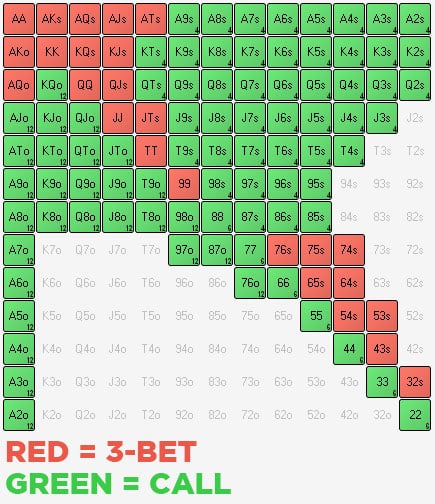The big blind must place a bet without even looking at their cards, another disadvantage of this position is that you will play out of position against other players. This is often an unfavorable position where you can make mistakes. One example is opponents' raises (open).
- If you defend your mandatory bet too rarely, your chips will gradually dwindle, and opponents noticing this weakness will open more often, as it will be easy to steal your bet.
- If you defend the mandatory bet too often, you will get involved in post-flop play with weak cards and still play out of position.
So, it is clear that this position is quite problematic, so I will share six tips (3 for tournament players and 3 for cash players) that will help increase your winnings.
But before that, let's analyze one example for both poker formats, which will highlight the differences between big blind play in tournaments and cash games.
BB against BTN open (tournament example)
9 players are playing, blinds 100/200/20
BTN has 13000 (65BB)
BB has 7000 (35BB)
Hero is in the BB position and has Xx Xx
BTN opens 420, SB folds. Hero…
Question: With which cards should the hero defend the bet?
We should start by defining the BTN opening range:

Red – raise
Pink – raise/fold
Blue – fold
Before we lay out the cards with which the BB should defend, let's pay attention to a few factors that are specific to tournaments – antes + small opening size = better price to defend.
Antes and relatively small opening sizes mean that we can defend the big blind at a low cost. In a 9-player table, the antes add up to almost 1BB, combine this with relatively small opening sizes (2x – 2.5x) and we have a fairly clear picture of why we should defend the mandatory bet quite broadly.
In the given example, we need to put 220 into the pot to win 900, which means we need about 19.6% equity against the opponent's opening range. The BTN opens about 68% of all hands, which says a lot.
- Varying stack sizes
Because in tournaments we have variable stack sizes, the opening range constantly changes, unlike in cash games. Typically, players with a lot of chips open much wider than those with few chips. This way, those with larger stacks can apply pressure.
On the other hand, players with few chips can profitably 3-bet players whose RFI (raise first in) is high.
- Pure equity vs. realizable equity
When a hand has, say, 30% pure equity, it doesn't mean you will win the pot 30% of the time. This is because some hands play worse post-flop and therefore realize less equity.
Suited or connected cards realize equity best. Some hands can realize more equity than they have, for example, in some situations Jh Th against a wide-playing opponent or Ah As in all situations.
Considering what has already been discussed, let's construct the big blind defense range against the previously mentioned BTN open.

Red – 3-bet
Green – call
A lot of green! At first glance, it might even seem like too much, but let's look at the numbers, even with the worst possible hand against a 68% BU opening range:

Even say 32o realizes only two-thirds of its equity, which is more than the 19.6% you need for the call to be profitable. Don't get me wrong, this is a borderline situation that shouldn't be taken as the norm, but by folding you sacrifice a small part of your EV to the opponent.
If you feel uncomfortable playing post-flop with such cards, you can fold. However, this range construction shows how broadly you can defend the big blind against small frequent BTN opens. If good players can profitably defend 72o, you can certainly handle J3s.
BB against BTN open (cash example)
6 players are playing, blinds $1/$2.
BTN: $200 (100BB)
Hero (BB): $200 (100BB)
BTN opens $6, SB folds, hero…
Let's start by evaluating the BTN opening range:

Red – raise
Pink – raise/fold
Blue – fold
A reasonable BB defense range against a 3x open – calling $4 with a chance to win $9, is:

It is worth mentioning two key differences between this situation and the previously analyzed tournament example:
- The absence of antes and a typically larger opening size (3x) results in a worse price to defend the BB.
Because there are no antes, the pot is almost 1BB smaller than in the previous example.
A 3x open from the BB is 0.9BB larger than in the tournament example.
For these reasons, the cost of defending the BB is worse.
In this example, we need to call $4 to win $13, which means we need about 30.8% equity against the BTN opening range for our call to be profitable. Here, undoubtedly, the worst hand in our defense range against the BTN.

37% is significantly more than the 30.8% we need, and 76o against a wide BTN range realizes its equity quite well. If you are confident in your post-flop play, you can defend even wider.
- Rake
Unlike in tournaments, rake is paid for hands when a player reaches the flop, and sometimes even before the flop in some live games. On platforms where the rake is very high, you need to be prepared to adjust your play from the BB.
When playing small pots post-flop, you need to narrow your calling range due to reduced pot odds. Rake encourages 3-betting, as you pay nothing if the hand ends pre-flop.
In short: DON'T GIVE UP YOUR BIG BLIND SO EASILY!
And now a few tips for tournament and cash players.
3 tips for a solid BB strategy in tournaments
- Fight for the antes
Consider that antes should influence our BB defense and opening range.
Players tend to overlook the importance of antes because the chips we each put in as antes seem very small to us, but they significantly change our pot odds when all the antes are collected into a pile.
- Be more aggressive and use 3-bet shoves.
When you don't have many chips (less than 20BB), don't be afraid to 3-bet shove against opponents who open from late positions.
If you take measures and select the right hands with a lot of pure equity, you can accumulate a stack of chips and rise from tournament outsiders to leaders, just by using more aggression in the right place at the right time, and of course, a bit of luck.
- Don't be afraid to call when you have few chips.
The thinking that with 6-15BB you can only fold or shove against an open is wrong. This is outdated advice that certainly cannot be called true when you look at the odds from the BB.
If you face a small open and have a hand that is too weak to shove all your chips but too strong to fold, you can simply call.
3 tips for a solid BB strategy in cash games
- Pay attention to opening sizes.
Cash games are characterized by various opening sizes, ranging from 2x to 5x or 6x in live games. For this reason, your pot odds are different in each situation, it is important to be able to adapt to this and change your BB defense range.
- Take advantage of the positional advantage against the SB.
When everyone folds to the SB, you only need to eliminate one player to win the pot. This encourages the opponent to open very often. As the BB, this should encourage you to defend very often. You are in position, you know that the SB opening range is very wide, and you have already invested 1BB into the pot, it looks like a recipe for a wide defense range.
- Adapt to opponents' playing tendencies.
One of the advantages of cash games is that it is easier to find reliable observations about opponents' play after playing with the same players for a while.
Use this and adjust your BB defense strategy based on observations.
If a player who plays very narrowly opens, you should also narrow your defense range. Conversely, if you encounter a maniac who opens 80%, don't give up your blind without a fight.
Translated from: https://www.upswingpoker.com/big-blind-defend-strategy-mtt-vs-cash/






